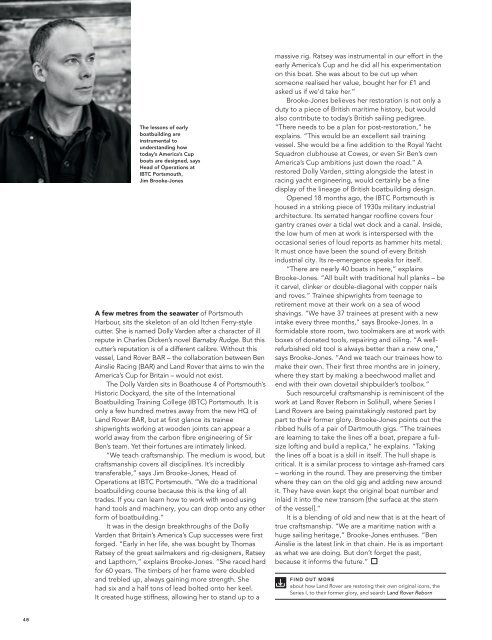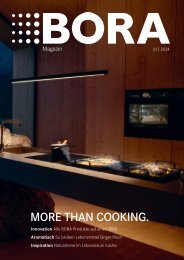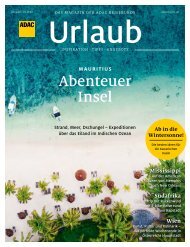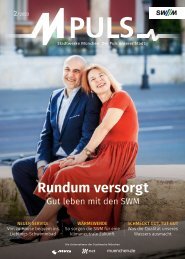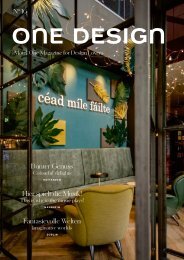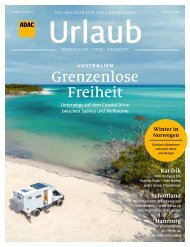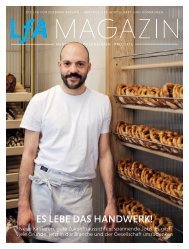ONELIFE #34 – English
Land Rover steht für höchste Allradkompetenz, umfassenden Komfort und anspruchsvolle Technik. Diesem Geländewagen ist kein Weg zu weit und keine Aufgabe zu schwer – getreu dem Slogan „Above and Beyond“. ONELIFE vermittelt Land Rover-Kunden genau dieses Gefühl von Abenteuer und Freiheit.
Land Rover steht für höchste Allradkompetenz, umfassenden Komfort und anspruchsvolle Technik. Diesem Geländewagen ist kein Weg zu weit und keine Aufgabe zu schwer – getreu dem Slogan „Above and Beyond“. ONELIFE vermittelt Land Rover-Kunden genau dieses Gefühl von Abenteuer und Freiheit.
You also want an ePaper? Increase the reach of your titles
YUMPU automatically turns print PDFs into web optimized ePapers that Google loves.
RATAN TATA<br />
The lessons of early<br />
boatbuilding are<br />
instrumental to<br />
understanding how<br />
today’s America’s Cup<br />
boats are designed, says<br />
Head of Operations at<br />
IBTC Portsmouth,<br />
Jim Brooke-Jones<br />
A few metres from the seawater of Portsmouth<br />
Harbour, sits the skeleton of an old Itchen Ferry-style<br />
cutter. She is named Dolly Varden after a character of ill<br />
repute in Charles Dicken’s novel Barnaby Rudge. But this<br />
cutter’s reputation is of a different calibre. Without this<br />
vessel, Land Rover BAR <strong>–</strong> the collaboration between Ben<br />
Ainslie Racing (BAR) and Land Rover that aims to win the<br />
America’s Cup for Britain <strong>–</strong> would not exist.<br />
The Dolly Varden sits in Boathouse 4 of Portsmouth’s<br />
Historic Dockyard, the site of the International<br />
Boatbuilding Training College (IBTC) Portsmouth. It is<br />
only a few hundred metres away from the new HQ of<br />
Land Rover BAR, but at first glance its trainee<br />
shipwrights working at wooden joints can appear a<br />
world away from the carbon fibre engineering of Sir<br />
Ben’s team. Yet their fortunes are intimately linked.<br />
“We teach craftsmanship. The medium is wood, but<br />
craftsmanship covers all disciplines. It’s incredibly<br />
transferable,” says Jim Brooke-Jones, Head of<br />
Operations at IBTC Portsmouth. “We do a traditional<br />
boatbuilding course because this is the king of all<br />
trades. If you can learn how to work with wood using<br />
hand tools and machinery, you can drop onto any other<br />
form of boatbuilding.”<br />
It was in the design breakthroughs of the Dolly<br />
Varden that Britain’s America’s Cup successes were first<br />
forged. “Early in her life, she was bought by Thomas<br />
Ratsey of the great sailmakers and rig-designers, Ratsey<br />
and Lapthorn,” explains Brooke-Jones. “She raced hard<br />
for 60 years. The timbers of her frame were doubled<br />
and trebled up, always gaining more strength. She<br />
had six and a half tons of lead bolted onto her keel.<br />
It created huge stiffness, allowing her to stand up to a<br />
massive rig. Ratsey was instrumental in our effort in the<br />
early America’s Cup and he did all his experimentation<br />
on this boat. She was about to be cut up when<br />
someone realised her value, bought her for £1 and<br />
asked us if we’d take her.”<br />
Brooke-Jones believes her restoration is not only a<br />
duty to a piece of British maritime history, but would<br />
also contribute to today’s British sailing pedigree.<br />
“There needs to be a plan for post-restoration,” he<br />
explains. “This would be an excellent sail training<br />
vessel. She would be a fine addition to the Royal Yacht<br />
Squadron clubhouse at Cowes, or even Sir Ben’s own<br />
America’s Cup ambitions just down the road.” A<br />
restored Dolly Varden, sitting alongside the latest in<br />
racing yacht engineering, would certainly be a fine<br />
display of the lineage of British boatbuilding design.<br />
Opened 18 months ago, the IBTC Portsmouth is<br />
housed in a striking piece of 1930s military industrial<br />
architecture. Its serrated hangar roofline covers four<br />
gantry cranes over a tidal wet dock and a canal. Inside,<br />
the low hum of men at work is interspersed with the<br />
occasional series of loud reports as hammer hits metal.<br />
It must once have been the sound of every British<br />
industrial city. Its re-emergence speaks for itself.<br />
“There are nearly 40 boats in here,” explains<br />
Brooke-Jones. “All built with traditional hull planks <strong>–</strong> be<br />
it carvel, clinker or double-diagonal with copper nails<br />
and roves.” Trainee shipwrights from teenage to<br />
retirement move at their work on a sea of wood<br />
shavings. “We have 37 trainees at present with a new<br />
intake every three months,” says Brooke-Jones. In a<br />
formidable store room, two toolmakers are at work with<br />
boxes of donated tools, repairing and oiling. “A wellrefurbished<br />
old tool is always better than a new one,”<br />
says Brooke-Jones. “And we teach our trainees how to<br />
make their own. Their first three months are in joinery,<br />
where they start by making a beechwood mallet and<br />
end with their own dovetail shipbuilder’s toolbox.”<br />
Such resourceful craftsmanship is reminiscent of the<br />
work at Land Rover Reborn in Solihull, where Series I<br />
Land Rovers are being painstakingly restored part by<br />
part to their former glory. Brooke-Jones points out the<br />
ribbed hulls of a pair of Dartmouth gigs. “The trainees<br />
are learning to take the lines off a boat, prepare a fullsize<br />
lofting and build a replica,” he explains. “Taking<br />
the lines off a boat is a skill in itself. The hull shape is<br />
critical. It is a similar process to vintage ash-framed cars<br />
<strong>–</strong> working in the round. They are preserving the timber<br />
where they can on the old gig and adding new around<br />
it. They have even kept the original boat number and<br />
inlaid it into the new transom [the surface at the stern<br />
of the vessel].”<br />
It is a blending of old and new that is at the heart of<br />
true craftsmanship. “We are a maritime nation with a<br />
huge sailing heritage,” Brooke-Jones enthuses. “Ben<br />
Ainslie is the latest link in that chain. He is as important<br />
as what we are doing. But don’t forget the past,<br />
because it informs the future.”<br />
FIND OUT MORE<br />
about how Land Rover are restoring their own original icons, the<br />
Series I, to their former glory, and search Land Rover Reborn<br />
48


